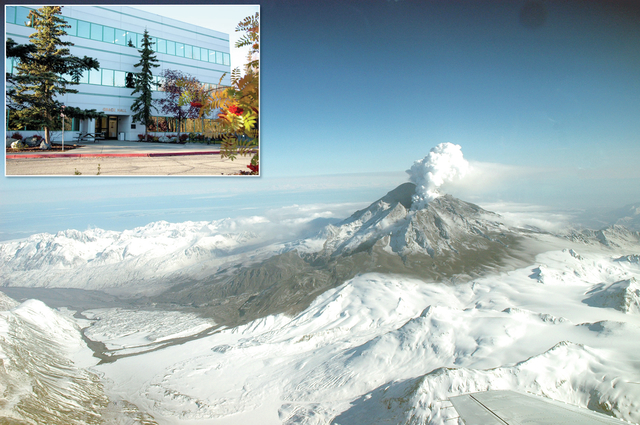As part of Volcano Awareness Month, our January Volcano Watch articles are exploring the U.S. Geological Survey’s volcano observatories and their connections to Hawaii. We continue this week with a visit to Alaska. ADVERTISING As part of Volcano Awareness Month,
As part of Volcano Awareness Month, our January Volcano Watch articles are exploring the U.S. Geological Survey’s volcano observatories and their connections to Hawaii. We continue this week with a visit to Alaska.
Hawaii might be the most volcanically active state, but in terms of sheer numbers of volcanoes, Alaska is the hands-down winner in the U.S. Of the nation’s 169 active volcanoes, 90 are located in Alaska. Eruptions there are common, and some volcanoes are in a semi-constant state of low-level activity.
The 1986 eruption of Augustine Volcano in Cook Inlet (near Anchorage) emphasized the need for volcano monitoring and research in Alaska. It also prompted the establishment of the Alaska Volcano Observatory, which was founded in 1988.
AVO is a partnership between three organizations: the U.S. Geological Survey, the Geophysical Institute of the University of Alaska Fairbanks, and the Alaska Division of Geological and Geophysical Surveys. These three groups contribute observatory operations, although hazards notifications are issued by the USGS, which has federal responsibility for such declarations.
AVO did not have to wait long after its establishment for its first “test.”
On Dec. 14, 1989, Redoubt Volcano, also in Cook Inlet, erupted. The next day, KLM Flight 867, carrying 231 passengers from Amsterdam to Tokyo with a stop in Anchorage, flew through a Redoubt ash plume, causing all four engines to fail. The aircraft dropped more than 3 km (2 mi) in altitude within five minutes before the flight crew managed to restart the engines and land the plane safely in Anchorage. All four engines on the aircraft had to be replaced, with damages totaling about $80 million. The Redoubt eruption continued through early June 1990.
The KLM Flight 867 incident reemphasized that hazards from even remote volcanoes can impact an increasing number of vulnerable jet aircraft — a lesson that previously was demonstrated by similar ash-aircraft encounters around the world.
These encounters represent a significant difference in emphasis between AVO and the Hawaiian Volcano Observatory.
In Hawaii, we focus primarily on ground-based volcanic hazards such as lava flows, whereas Alaska has ground and airborne concerns. AVO’s area of responsibility also is much broader than that of HVO, extending from southeast Alaska to Anchorage, along the Alaska Peninsula and then out the chain of Aleutian Islands toward Russia’s Kamchatka Peninsula — a distance of more than 3,000 km (2,000 mi).
Nevertheless, AVO uses volcano monitoring methods similar to those employed by HVO, including webcams, seismic and GPS stations, and geological mapping. Ground-based monitoring and research field work are considerable challenges owing to Alaska’s harsh environment and the remoteness of so many volcanoes, so satellite data are used extensively.
Aircraft pilot reports also are important sources of information about Alaskan volcanoes. In fact, it was pilot reports, confirmed by satellite data, that documented the unheralded Dec. 20, 2016, eruption of Bogoslof — a tiny island with no ground-based volcano monitoring — which sent an ash plume to an altitude of more than 10 km (6 mi).
Since its founding, AVO has made tremendous strides in mapping the largely unknown volcanoes of Alaska to better understand their eruptive histories and future eruptive potential. Even some of the remote volcanoes of the western Aleutian Islands have been instrumented to track unrest and detect eruptions that might be hazardous to aircraft.
AVO also developed state-of-the-art tools for viewing the abundance of available satellite observations that can detect ash plumes and thermal anomalies. Some of these tools were exported to Hawaii, where HVO scientists use them to enhance their monitoring of Kilauea and Mauna Loa volcanoes.
Scientists at AVO are researching Alaskan volcanoes to contribute to a better understanding of how volcanoes work in general. Of particular importance are AVO’s investigations into the dynamics of explosive eruptions and their deposits, relations between seismic energy and ash plumes and hydrologic hazards due to eruptions at snow- and ice-covered volcanoes.
Next week, we’ll visit the most populous state in the U.S., which is also home to 19 active volcanoes — California.
In the meantime, we hope to see you at our upcoming Volcano Awareness Month programs on the Big Island. The complete schedule, including descriptions of the talks, is posted on HVO’s website at hvo.wr.usgs.gov.
Volcano activity updates
Kilauea continues to erupt at its summit and East Rift Zone.
This past week, the summit lava lake level varied between about 16.5 and 33.5 m (54 and 110 ft) below the vent rim. The 61g flow was still active, with lava entering the ocean near Kamokuna and surface breakouts near Pu‘u ‘O‘o.
The 61g flow does not pose an immediate threat to nearby communities.
Mauna Loa is not erupting. During the past week, small-magnitude earthquakes continued, primarily beneath the upper Southwest Rift Zone and summit caldera at depths of less than 5 km (3 miles).
GPS measurements continue to show deformation related to inflation of a magma reservoir beneath the summit and upper Southwest Rift Zone, although rates appear to have slowed during the past month.
Two earthquakes recently were reported felt in Hawaii.
At 2:20 p.m. Jan. 9, a magnitude-3.1 earthquake occurred 62 km (38.5 mi) southwest of Lanai City, Lanai, at a depth of 10 km (6.2 mi). At 10:24 a.m. Jan. 7, a magnitude-3.5 earthquake occurred 16 km (9.9 mi) north of Pahala at a depth of 9.4 km (5.8 mi).
Visit the HVO website (http://hvo.wr.usgs.gov) for past Volcano Watch articles, Kilauea daily eruption updates, Mauna Loa weekly updates, volcano photos, recent earthquakes info, and more; call for summary updates at 808-967-8862 (Kilauea) or 808-967-8866 (Mauna Loa); email questions to askHVO@usgs.gov.
Volcano Watch (http://hvo.wr.usgs.gov/volcanowatch/) is a weekly article and activity update written by U.S. Geological Survey Hawaiian Volcano Observatory scientists and colleagues.



